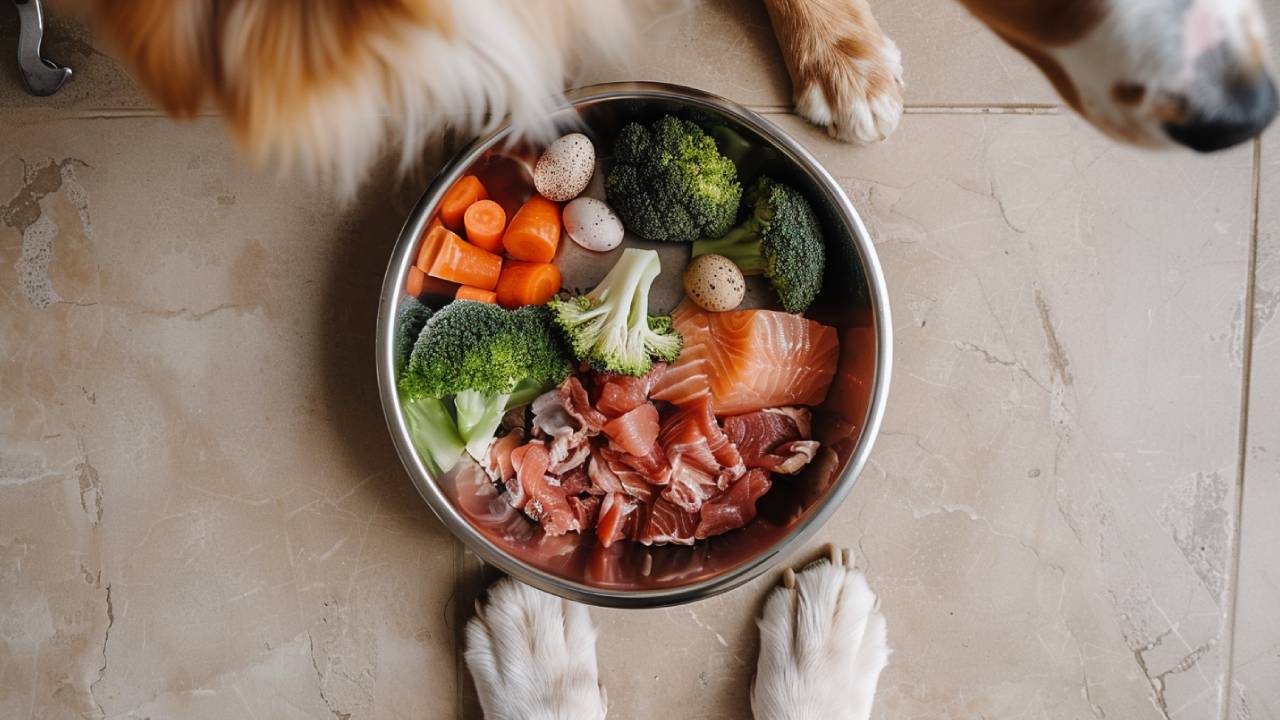One dietary trend that has gained momentum in recent years is feeding dogs raw foods. Advocates claim that a raw diet can provide numerous health benefits to our canine companions.
In this article, we will delve into the world of raw foods for dogs, discussing the differences between fresh and raw, the concept of a raw diet, the potential dangers of feeding raw meat, and recent research.
Raw Dog Food Diet: What the Research Shows
Recent studies have explored the benefits and risks of raw diets for dogs. Some research suggests that raw diets can improve coat condition, smaller stools, and better dental health.
However, other studies have raised concerns about the risk of bacterial contamination and nutritional imbalances.
It’s essential to stay updated on the latest research findings and consult a veterinarian to make an informed decision about your dog consuming raw food.
Fresh Food vs. Raw Food
Nutrition is paramount in the well-being of our four-legged friends, so it is important to know the benefits of fresh vs raw food for dogs. Here are some of the key advantages of incorporating each type of food into your dog’s diet:
| Fresh Food | Raw Food | |
|---|---|---|
| Nutritional content | High in essential nutrients, vitamins, and minerals. Optimal for balanced growth and vitality. | Maximum nutrient retention. Ideal for absorption of natural vitamins and minerals. |
| Digestive health | Promotes better digestion with less processed ingredients. Minimizes digestive disorders. | Mirrors ancestral diet, reducing strain on the digestive system from processed foods. |
| Dental benefits | Raw bones and some crunchy veggies help clean teeth and maintain gum health. | Raw bones are integral, preventing tartar buildup and strengthening jaw muscles. |
| Weight management | Easier calorie control through customizable portion sizes. | Natural high-protein diet helps sustain ideal body weight and muscle mass. |
| Immune health | Boosts immunity with a variety of whole, fresh ingredients. | Strengthens immune defenses naturally with unprocessed, fresh ingredients. |
| Allergy reduction | Fewer allergies due to absence of common allergens found in commercial foods. | Minimizes exposure to artificial additives and allergens, reducing allergy risks. |
| Energy and vitality | Supports high energy levels with nutrient-rich, easily digestible foods. | Enhances overall vitality and alertness through a diet rich in high-quality proteins. |
Need to know: For raw diets, ensure that all meat is sourced from reputable suppliers to minimize the risk of contamination with pathogens such as Salmonella or E. coli.
While fresh diets typically involve less risk, they still require careful handling, especially when including raw vegetables and fruits.

What to Choose: Raw or Fresh Food?
Deciding between a raw diet and a fresh diet for your dog depends on various factors, including your dog’s specific needs, lifestyle, and comfort level with handling raw ingredients. Both options have their benefits.
The choice between raw and fresh food should be based on your dog’s needs and willingness to follow safety guidelines. Consulting with a veterinarian can help you make the best decision for your canine companion. Ensuring food safety through proper handling and sourcing is crucial when considering a raw diet.
Consult with a veterinarian to create a safe and balanced raw food plan tailored to your dog’s specific needs. Additionaly, explore options for dog insurance. It could be beneficial to manage expenses effectively.
So, both options can provide significant health benefits with the right preparation and ongoing attention to a dog’s health and diet. Always engage with a veterinary professional to tailor the diet that best suits your pet’s needs, ensuring they receive the right balance of nutrients to live a healthy, happy life.

FAQs
How should I transition my dog to a raw food diet?
Transitioning to a raw diet should be done gradually over several weeks. Start by mixing a small amount of raw food with their current diet, gradually increasing the proportion of raw food while decreasing their traditional food until the switch is complete. Monitor your dog for any signs of digestive upset or allergies during this transition.
Are there any dog breeds that require special attention to their dietary needs?
Yes, some breeds have specific dietary requirements due to health predispositions. For example, large breeds like Great Danes may need joint-supportive nutrients, while breeds with sensitive stomachs like Bulldogs might benefit from a gently cooked, fresh diet.
Can all dogs switch to a raw food diet?
Not all dogs are good candidates for a raw diet. Puppies, pregnant or nursing dogs, elderly dogs, or those with compromised immune systems may require diets with specific nutritional formulations. Always consult a veterinarian before switching your dog’s diet, especially for dogs with health concerns.
What types of raw foods are recommended for dogs?
Recommended raw foods for dogs include muscle meat, organ meats (like liver and kidneys), raw bones, finely ground for safety, and some vegetables and fruits for added nutrients. Ensure that the diet is well-balanced according to veterinary nutrition guidelines.
How can I ensure the raw food diet is safe and balanced?
To ensure safety and nutritional balance, consult a veterinarian or a pet nutritionist familiar with raw diets. They can help formulate a diet that meets your dog’s specific needs. Additionally, practicing good food hygiene, like washing hands and surfaces thoroughly after handling raw meat, is crucial.
References:
For further reading and to deepen your understanding of the dietary needs and safety considerations for feeding your dog, please explore the following resources:
- Risks of Nutritional Imbalances – The potential dangers of nutritional imbalances that can occur with raw diets and how to avoid them.
- Raw Diets for Dogs and Cats: A Review, Concerning Microbiological Hazards – Exploring the benefits and risks of raw diets by focusing on microbiological hazards.
- Food Safety Dangers of Raw Pet Food: This section covers the safety concerns and best practices for handling raw pet food to prevent foodborne illnesses.
- Nutrient Sufficiency Through a Dog’s Lifetime – Discover the importance of ensuring nutrient sufficiency for your dog at different stages of life, especially when considering a raw food diet.






I’ve been thinking about switching my dog to a raw diet.